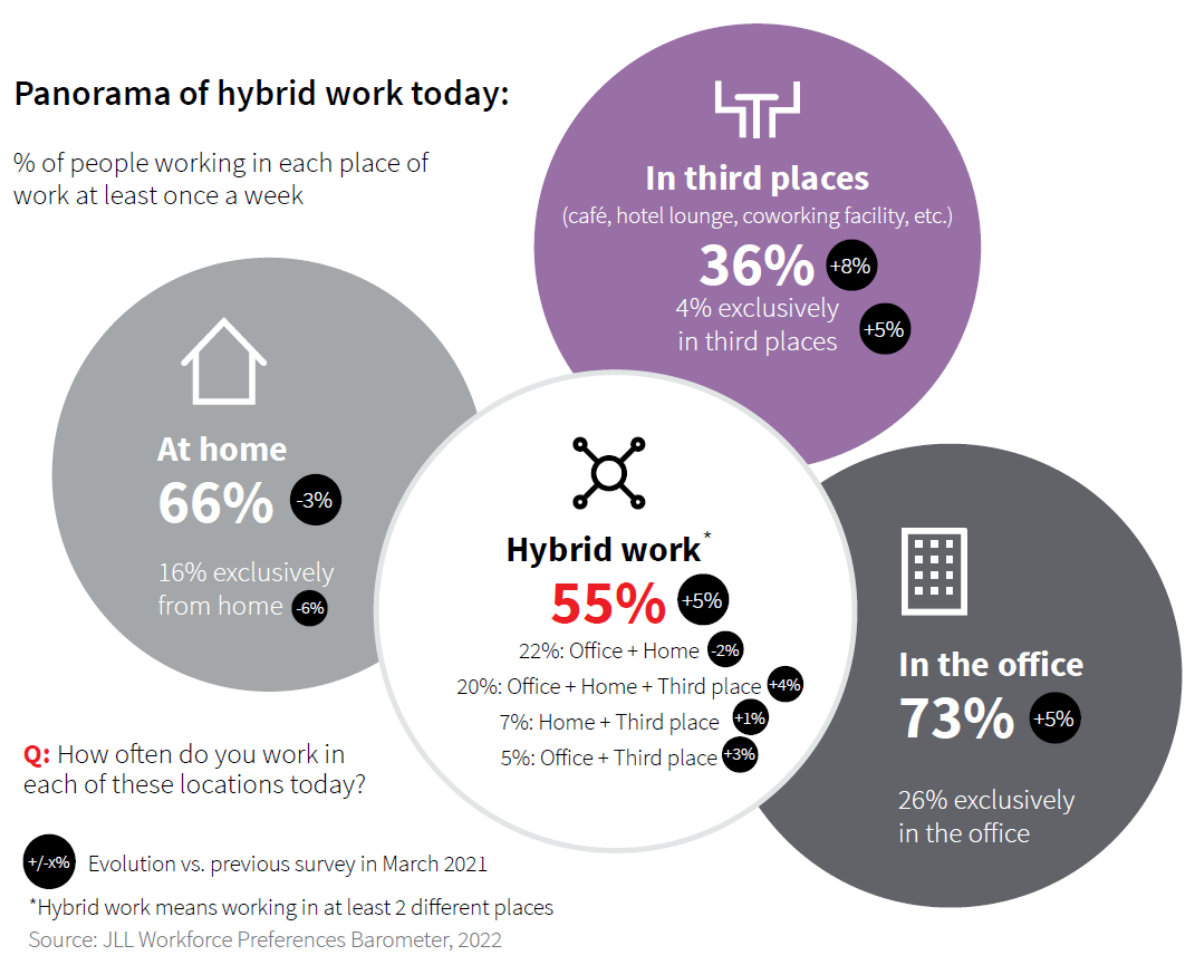Flagged as a “landmark in the history of work,” adoption of the hybrid work model appears set to drive widespread and lasting changes in the need for workspace, while also presenting employers with new opportunities and challenges. That’s according to JLL’s “Workforce Preferences Barometer” report, released earlier this month.
 JLL’s survey of more than 4,000 office workers worldwide concluded that hybrid work has reached its “optimal point.”
JLL’s survey of more than 4,000 office workers worldwide concluded that hybrid work has reached its “optimal point.”
“Hybrid work has become the most popular way of working today,” the report said. Overall, 73 percent of workers are going to the office at least once a week and 55 percent of office workers alternate between different workplaces during the week. Both of those rates are up 5 percent since spring 2021.
Interest in hybrid work dropped slightly in the past year – from 63 percent in 2021 to 60 percent currently. However, office workers have largely settled on how they want to divide their time. On average, workers expect to spend 2.7 days per week in the office and 2.3 days working elsewhere, according to the JLL report. Workers are also clarifying where they want to spend their time.
“Hybrid work is becoming more complex as a growing proportion of employees not only work from their home but also from third places like coworking facilities,” the report states. “Thirty-six percent of employees work in third party places on a weekly basis (+8 percent vs. March 2021), 33 percent are attracted by the possibility of gaining access to coworking facilities or satellite offices close to their home.”
The widespread embrace of the hybrid model is driven in part by two priorities among workers.
First, workers rank quality of life, including work-life balance, as their number one priority, according to the JLL study. “Three in four employees would reconsider their involvement with their company because they want to have greater flexibility and more quality time with their family or for other personal pursuits.”
Second, workers are seeking situations where they can be both individually productive and engaged with their companies.
 “Strikingly, the feeling of being more productive at home for heads-down work keeps growing among remote workers,” the JLL report says. “As they have become more used to their new homeworking routine, 47 percent believe they are more productive at home than in the office when it comes to delivering individual, focused work. This figure was 37 percent a year ago.”
“Strikingly, the feeling of being more productive at home for heads-down work keeps growing among remote workers,” the JLL report says. “As they have become more used to their new homeworking routine, 47 percent believe they are more productive at home than in the office when it comes to delivering individual, focused work. This figure was 37 percent a year ago.”
However, workers want vibrant, well-managed hybrid models that support face-to-face collaborative work, social interactions, synergies and alignment with a common company vision, the report said. Currently, 25 percent of workers feel isolated, 50 percent miss social interactions with coworkers and 44 percent miss the common understanding and bonding that happens during in-person work.
Employers, it seems, cannot afford to ignore those preferences in their decisions about either workspaces or management practices. Employees are expressing gratitude and enthusiasm for companies that are excelling in creating an engaging hybrid work model.
“Notably, hybrid work is providing an improved sense of commitment and autonomy,” the report states. “Forty-five percent of the workforce feel very engaged in their job today and 39 percent feel highly empowered. These figures were respectively 39 percent and 31 percent a year ago.”
However, many workers believe their employers are not yet succeeding in creating this new work environment. According to JLL, “only 1 in 2 employees is convinced that their company remains a great place to work; 1 in 4 has reconsidered the part that work plays in their life; [and] 1 in 4 is envisaging leaving their employer in the coming year.”